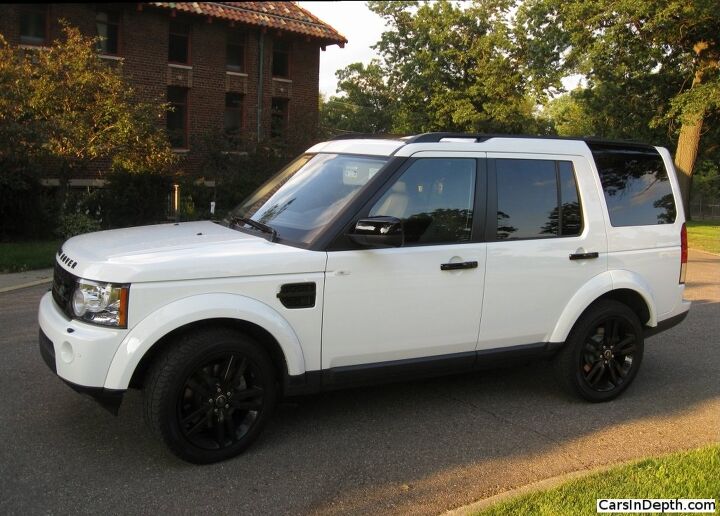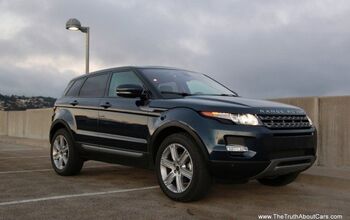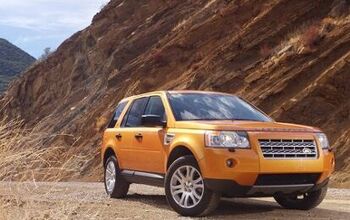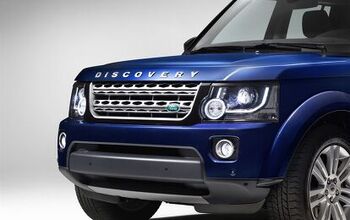Review: 2013 Land Rover LR4

My friends and neighbors have gotten used to the sight of a variety of brand new and nicely equipped cars that periodically show up on my driveway. They know that many (most? all?) of them are beyond my own means to own or lease so a frequent question I’m asked is, “who would buy that car?” Who would buy a 2013 Land Rover LR4? A snarky answer would be nobody, since it’s a safe bet that most of the 600 or so new LR4s that get delivered every month in North America are leased, but my guess is that the typical buyers are affluent suburban families with children and maybe a vacation home on an unpaved road. Who else would drive a 7 passenger luxury SUV?
With permanent seating for five adults and two flip up seats in the back, which could be used to transport grown ups if needed but are really more suited to car pooling kids to school, the LR4 will likely be used mostly as a mommymobile. Once mom does flip up those far back seats, she’s probably going to want to leave them up unless she needs the cargo space because they’re a bit of a PITA to put up or down. Speaking of things that are awkward, the clamshell rear end, with both a short lift gate and an actual tail gate may be a bit of a Land Rover styling signature, but the tail gate, with its asymmetrical cutout that lets you get closer to the cargo hold, still makes for a long reach when getting things in and out of the back.
How most LR4s will be used most of the time will be nowhere near their capabilities. The LR4 has got the equipment and features to be a very competent off-road vehicle, but the simple fact is that most LR4s will likely never leave pavement. If they do it will be down a gravel driveway or two-track to a summer home.
The LR4 comes with what Land Rover calls “permanent four wheel drive with traction control”, a two-speed transfer case, a locking center differential, LR’s five position “Terrain Response System” that lets you select an appropriate mode for a variety of unpaved surfaces, hill descent control, and fully independent suspension with electronically controlled air springs that automatically levels the car in response to load conditions and has an off-road setting that increases ground clearance by about 2.5 inches from the normal 7.3″ ride height. Should you take it off-road, the undercarriage is protected by skid plates. My suspicion, though, is that if a typical LR4 driver uses any of those features, it will be about 1% of the time. In addition to the off-road and normal ride heights, there is also an “access level” setting, that drops the truck’s body a couple of inches, to make ingress and egress easier. It can also be locked in that position (low speeds only, if you go too fast with the body raised or lowered, the LR4 will automatically return to normal ride height) for dealing with parking structures that have low clearance. It seems to me that in regular use, the three position switch will rarely, if ever, go into the raised position. It also seems to me that the typical driver will appreciate the fact that the driver’s seat automatically lowers itself and the power adjusted steering wheel is lifted out of the way as you prepare to exit the vehicle.
That capable air suspension may not end up getting a workout in the boonies but it is wonderful for driving around the frost heaved and financially distressed Detroit area roads where I live. I even started looking for low curbs and potholes to run over, to marvel at how the Land Rover just soaks up road irregularities. There’s a road not far from my home where the asphalt has been beaten into an oscillating mess. The road surface discombobulates most cars at any speed. The LR4 handled the bumps with aplomb.
Mom and kids will have a comfortable ride on the way to school. It also handles pretty well on pavement for a truck, and it is a truck. Land Rover calls the architecture “integrated body frame”. What that means is essentially a unibody structure welded to a traditional ladder frame. The LR4 is sturdy, but even with some aluminum body panels, it weighs more than 2 1/2 tons, 5,623 lbs to be exact. That’s about 400 pounds more than a Duesenberg Model J. Even when carpooling with little kids, a fully loaded LR4 will tip the scales at over 3 tons.
Steering is precise and quick, if a bit lacking in feel. The LR4 has a remarkably tight turning radius for a vehicle of its size, 18.8 feet. By comparison, a Chrysler 300 sedan has a 19.4′ turning radius. At the steering wheel it’s just a bit over three turns lock to lock. Also, the LR4 is not as large as it seems. The LR4 is tall, wide and heavy, but it’s not that long, 191 inches, only about 2″ longer than a Toyota Camry, and since it’s designed to be able to climb over things like a Camry there’s not much overhang, particularly at the front of the truck. Add in the four wheel drive and various sophisticated drivetrain components and stability controls and the result is a fairly maneuverable SUV. It’s also not slow. Zero to sixty times are stated as 7.5 seconds, which would have been considered quick in any other time than our horsepower addled age. The six speed automatic made by ZF worked flawlessly. You can shift it yourself if you want to, but it’s one of those bassakwards automanual gear selectors that have you push forward to go up a gear.
I like the brakes. They are probably the best modulated brakes of cars I’ve driven recently. Considering the mass involved their performance was impressive, though I’d prefer a bit more initial bite. The one time I had to make an unexpected stop there was no drama.
Again, this is a truck, not a crossover. You sit up high, with a commanding seating position. I could look F-150 and Silverado drivers pretty much in the eye. With a very square front end and the front wheels at the corners, you can easily see the front corners. It was very easy to place the LR4 on the road. Though the rear side windows that extend into the roof, a Land Rover styling cue, are a bit of an illusion since the view from the inside is masked, visibility to the rear is very good.
I alluded to the affluence of the target audience of the LR4. The one I had, in Fuji white with a Black Design Package that replaces all chrome brightwork with very sharp looking glossy black trim, stickered out at $64,145, with about $15K worth of options. The 7 Seat LUX package is $9,225 and gets you nice power leather seats, power steering column, special black 19″ wheels, a fridge in the console, and a 17 speaker, 825 watt harman/kardon Logic 7 branded sound system. That package include both the HSE and Classic Comfort packages, which gives you multiple zone automatic climate control. The black on white color scheme looks fabulous, and people remarked about what a nice looking vehicle it is, but that glossy black trim will also set you back $3,500. If you want a rugged looking white vehicle with black trim but you don’t want to spend an additional $3,500, I believe that look is standard on the Ford E-150.
Not only isn’t the LR4 cheap to buy, it’s not going to be cheap to drive. I had originally hoped to take the LR4 to The Mounds, a county owned off-road driving park north of Flint, Michigan. Press cars only come with one tank of gas, the 375 HP, 375 ft lbs, Jaguar V8 under the hood runs on premium gasoline.
The LR4 comes with two glove boxes and a little storage cubby.
Still, it’s only about a 120 mile round trip and I did talk to the park director thinking that it’d be nice to try out the Land Rover in it’s intended habitat and maybe even do a story about The Mounds, which is unique enough that they get off-road enthusiasts from as far away as Texas. However, after the first quarter tank of gas returned 9.5 MPG, a figure I haven’t personally seen since I could buy gas for two-bits a gallon, I changed my plans. Come to think of it, I don’t think I’ve ever driven another car that got less than 10 over that kind of distance. My late father’s 1966 Olds 88 with a 425 big block and a 4 barrel carb got 11 MPG.
Suspension pieces are the definition of beefy.
So I scotched that trip and instead used the LR4 the way it is likely to be used, driving around the suburbs, with an occasional highway trip or excursion into the city. I barely got over 200 miles range on the full tank, with an overall average of 12.9 MPG – compared to a combined EPA rating of 14. I’ll have to check my Jaguar reviews, but offhand I think the mileage that I got was even a bit worse than with the two XF Supercharged models I tested, and those have 470 HP.
Skid plates standard
The LR4 is slated for a mid-cycle refreshment and spy pics have already been spotted of the car with revised headlamps. The current car is perfectly comfortable, even somewhat luxurious, certainly in its features, but while the utilitarian, mostly black plastic interior trim fits with the LR4’s off-road capabilities and credentials, and while the fit and finish is appropriate for a vehicle that expensive, it seems a bit spartan for $64,000 and, according to reports, the interior on the next Discovery/LR5 will also be upgraded as well. It’s not surprising that also being replaced is the thirsty Jaguar V8 . Instead the base engine will be the supercharged V6 introduced in the new Jaguar F Type. No word from Jaguar on whether or not a diesel will be available in North America.
Will it Zayde?
Unlike the new fathers in the autoblogosphere, like our own Brendan Macaleer, or Jalopnik’s Jason Torchinsky, this is my second time around with small children. Once a week I babysit my 14 month old grandson, Aryeh Leib. When Jason does car reviews, he includes a “ Will it baby?” assessment of how well that vehicle suits the needs of parents of small children, so with his gracious permission I’d like to introduce “Will it Zayde?” The access level setting on the air suspension (must remember to activate it before shutting everything down) does make it easier to get a baby laden car seat in and out of the back seat. I wouldn’t even try putting one in the way back. Putting a car seat in the car does have one hangup. The seat belt latches for the regular rear seats are mounted on hinged arms that retract into a recess to allow the seats to lie fully flat when folded. That makes buckling a child car seat into those seats a two hand task, one for lifting up the latch and the other to insert the buckle. Since you have to reach over the car seat to do that, it’s rather awkward.
In summary, other than the poor fuel economy, I liked the LR4. It’s comfortable, handles well for a truck and it is likely to get you there no matter the road conditions. It won’t be cheap to buy or own, but then that’s not likely to be a concern for someone willing to spend $64K on a station wagon to get the kids to school and mom to her yoga classes.
Ronnie Schreiber edits Cars In Depth, a realistic perspective on cars & car culture and the original 3D car site. If you found this post worthwhile, you can dig deeper at Cars In Depth. If the 3D thing freaks you out, don’t worry, all the photo and video players in use at the site have mono options. Thanks for reading – RJS

Ronnie Schreiber edits Cars In Depth, the original 3D car site.
More by Ronnie Schreiber
Latest Car Reviews
Read moreLatest Product Reviews
Read moreRecent Comments
- Bkojote Allright, actual person who knows trucks here, the article gets it a bit wrong.First off, the Maverick is not at all comparable to a Tacoma just because they're both Hybrids. Or lemme be blunt, the butch-est non-hybrid Maverick Tremor is suitable for 2/10 difficulty trails, a Trailhunter is for about 5/10 or maybe 6/10, just about the upper end of any stock vehicle you're buying from the factory. Aside from a Sasquatch Bronco or Rubicon Jeep Wrangler you're looking at something you're towing back if you want more capability (or perhaps something you /wish/ you were towing back.)Now, where the real world difference should play out is on the trail, where a lot of low speed crawling usually saps efficiency, especially when loaded to the gills. Real world MPG from a 4Runner is about 12-13mpg, So if this loaded-with-overlander-catalog Trailhunter is still pulling in the 20's - or even 18-19, that's a massive improvement.
- Lou_BC "That’s expensive for a midsize pickup" All of the "offroad" midsize trucks fall in that 65k USD range. The ZR2 is probably the cheapest ( without Bison option).
- Lou_BC There are a few in my town. They come out on sunny days. I'd rather spend $29k on a square body Chevy
- Lou_BC I had a 2010 Ford F150 and 2010 Toyota Sienna. The F150 went through 3 sets of brakes and Sienna 2 sets. Similar mileage and 10 year span.4 sets tires on F150. Truck needed a set of rear shocks and front axle seals. The solenoid in the T-case was replaced under warranty. I replaced a "blend door motor" on heater. Sienna needed a water pump and heater blower both on warranty. One TSB then recall on spare tire cable. Has a limp mode due to an engine sensor failure. At 11 years old I had to replace clutch pack in rear diff F150. My ZR2 diesel at 55,000 km. Needs new tires. Duratrac's worn and chewed up. Needed front end alignment (1st time ever on any truck I've owned).Rear brakes worn out. Left pads were to metal. Chevy rear brakes don't like offroad. Weird "inside out" dents in a few spots rear fenders. Typically GM can't really build an offroad truck issue. They won't warranty. Has fender-well liners. Tore off one rear shock protector. Was cheaper to order from GM warehouse through parts supplier than through Chevy dealer. Lots of squeaks and rattles. Infotainment has crashed a few times. Seat heater modual was on recall. One of those post sale retrofit.Local dealer is horrific. If my son can't service or repair it, I'll drive 120 km to the next town. 1st and last Chevy. Love the drivetrain and suspension. Fit and finish mediocre. Dealer sucks.
- MaintenanceCosts You expect everything on Amazon and eBay to be fake, but it's a shame to see fake stuff on Summit Racing. Glad they pulled it.














































































































































Comments
Join the conversation
What I didn't get from this review was whether they had improved the navigation/infotainment system. I was very close to buying one of these last year, but the absolutely horrendous lag time between touch-screen-press and system-response was a total dealbreaker for me. Anyone know the answer? And anyone who suggests a Tahoe, I'll have you know I did look at one but couldn't get any kind of decent trim level without chrome. Chrome anything, chrome wheels, chrome accents, etc. And that was a dealbreaker for me. Death to chrome wheels and the like.
Land Rover: Most of the good things about a half ton crew cab without any of the stigma of working for a living.